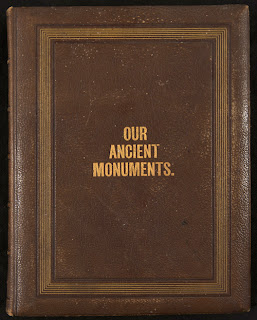Image: cover of the newly-discovered Our Ancient Monuments volume, made by General Pitt-Rivers in the 1880s
This month's issue of British Archaeology magazine (Jan-Feb 2013) has a full-page news article (on page 7) on the Excavating Pitt-Rivers project. The news article outlines our discovery of previously unknown material, among a new donation to the Pitt Rivers Museum from the Pitt-Rivers family. The details of the news item are below. The new material includes a unique album of watercolours, site plans and photographs, titled Our Ancient Monuments, which will be researched and published by the Excavating Pitt-Rivers project team. To subscribe to British Archaeology - which is published by the Council for British Archaeology - or to see the full news item on their itunes app, visit http://www.britisharchaeology.org/subscribe
Extraordinary treasures from founding archaeologist
A surprise collection has come to light, informing the work
of a key 19th-century archaeologist and collector. Photos and illustrations – some
loose, many in albums – notebooks, documents and letters had been carefully
saved by General Augustus Pitt-Rivers (1827–1900) and his descendants.
image: news article about the Pitt-Rivers material in the Jan-Feb 2013 issue of British Archaeology magazine: to see the full news item see their itunes app - www.britisharchaeology.org/subscribe
Anthony Pitt-Rivers, the General’s great-grandson, showed
the material about a year ago to Jeremy Coote, curator and joint head of
collections at the Pitt Rivers Museum, University of Oxford, and principal
investigator on the museum's Rethinking Pitt-Rivers Project. In what Coote dubs
“an extraordinary act of generosity”, Pitt-Rivers has now donated most of the
items and temporarily loaned the rest.
The documents are still being catalogued, but their importance
for understanding 19th century collecting, anthropology and archaeology is
immediately clear. The donation includes 16 notebooks, dating back to 1840,
that detail the General’s varied activities. Among them is Catalogue of Arms
(1862), listing over 500 items from Madagascan lances to Chinese swords then in
his house in Clapham, London, and most now part of the collection in Oxford.
Commonly known as “the father of scientific archaeology”,
General Pitt-Rivers pioneered systematic excavation, public education and
collecting on a truly grand scale. His first collection became the core of the
eponymous Oxford museum, but his second, which continued to be exhibited by his
family at his private museum in Dorset well into the 20th century, was
dispersed from the 1950s. The newly revealed documents will throw light on
these accomplishments.
Three large albums entitled Photographs of Rushmore &
Environs, loaned to the museum, contain over 200 photos showing his house and
estates, taken in the 1890s by his secretary Harold St George Gray (1867–1963),
who became an archaeologist in his own right. They feature outdoor scenes and
detailed interiors of the house and its voluminous contents. Two smaller photo
albums are dedicated to archaeological excavations, one at South Lodge Camp
(1893), the other at Martin Down Camp (1895–96), both on the General’s estate
and well known to archaeologists today. Among loose items are previously
unknown records of an excavation in Denmark in 1879.
What perhaps will most impress archaeologists, however, is a
fat album of watercolours (by the artist WS Tomkin), drawings in the General’s
characteristic style and photos, entitled Our Ancient Monuments.
Pitt-Rivers became the UK’s first inspector of ancient
monuments in 1882. As part of this job he toured the country, visiting ancient
sites and their owners. The album, compiled in the 1880s–90s, has the feel of a
record and souvenir of those times, with many of the featured sites appearing
in the 1882 Act’s schedule. Others, particularly in Scotland, are additional to
that list.
Having completed the Rethinking Pitt-Rivers Project (funded
by the Leverhulme Trust), the museum starts
Excavating Pitt-Rivers this December (funded by Arts Council England, see excavatingpittrivers.blogspot.com),
which will document the new items and English archaeological artefacts the
General collected before 1884.


No comments:
Post a Comment